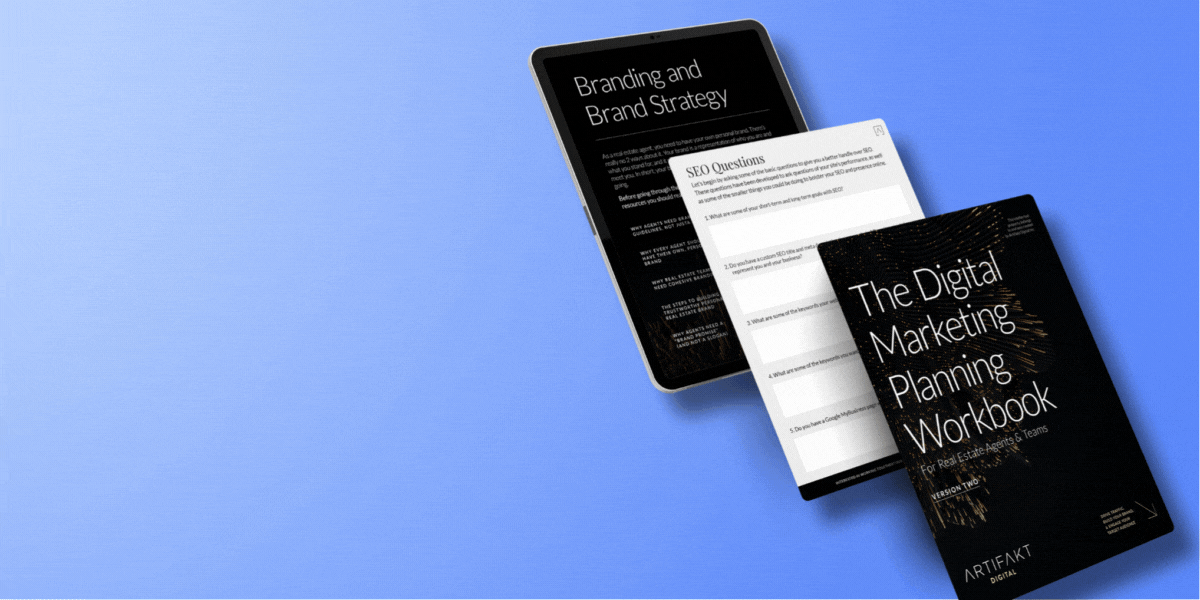For many agents, one of the first times they invest in their digital strategy is in their newsletter strategy.
Here at Artifakt, we’re firm believers in your website acting as the center of your marketing universe. But, if you don’t have the resources to invest in one, a newsletter can prove to be a great start.
This is especially true for agents who are just starting out or looking to build momentum. That’s because your newsletter leverages your sphere of influence and increases it at the same time.
Today, let’s talk about your newsletter, why you need one, and the five key traits of the highest-performing real estate newsletters in the industry.
Why Your Newsletter Is Essential
Almost every agent we interact with has a newsletter of some kind.
A common thread, though, is that the majority of them are simply used to promote listings. Whether present or upcoming, the problem is that the content variety stops there.
If an agent has a newsletter, they should be using it to create meaningful touch-points between themselves and potential leads. Simply treating it as a listing promotion tool is one piece of the puzzle, but it shouldn’t stop there.
A big piece of the strategy for a newsletter is to increase your referral business. Essentially, that means getting your newsletter shared, and that often relies on a host of key factors (that we’ll break down today).
Strategically, your newsletter not only needs to speak to your audience, but it also needs to expand your audience at the same time.
There are ways to do this, but simply sharing listings is hampering your newsletter’s true potential.
The Five Key Traits Your Newsletter Needs
As you’re building your real estate newsletter, there are five key traits worth keeping in mind.
These are important to performance, to function, and to the metrics that will ultimately govern just how successful your newsletter can be for your business.
Let’s break them down right now:
1. It’s Custom To Your Brand
At its core, a newsletter needs to have a streamlined look to it.
That is mainly for functionality. You want to ensure that your newsletter “plays well” with multiple devices, screen sizes, and doesn’t break or look broken (which can be damaging to your brand).
Instead, you need to ensure that your brand pops. That includes the images you choose, the tone of your copy, or simply the inclusion of your logo (which, of course, we’d recommend having across all your marketing).
A custom template for a newsletter is something we do every day here at Artifakt. We focus on taking our client’s brands and creating a cohesive newsletter that authentically reflects their brand.
If your newsletter doesn’t look custom, in that it looks generic, you may be able to get people to open it — but you won’t get much beyond that, as the look will often hamper the performance of even the best content.
2. It’s Consistently Delivered To Your Audience
Once you have a designed template for your newsletter, that level of visual consistency is already accomplished.
The next step is to ensure you are consistent in how often your newsletter goes out. This is especially true if you want your newsletter to be a welcome addition to someone’s inbox. Your subscribers need to know when it’s coming.
That includes sending out your newsletter at the same time, every month, or biweekly or however best suits your ability to create content (or the agency you trust to create content for you).
While you may have the wiggle room to switch the day you send out your newsletter per month, your subscribers likely won’t appreciate large periods of inactivity.
In fact, we have seen escalating unsubscribe rates for agents who don’t send out a newsletter for months and then re-send them out, the “first newsletter back” phenomenon often reminds people that they don’t hear from you enough.
So, be consistent, not only in your brand’s look but in your send times.
3. It’s Striking The Right Tone
The best part about your newsletter is that it allows you to have hundreds of conversations, all at once.
That’s because, with properly written content, you can reach out to each of your subscribers in a way that feels personal to them. This is done through what we call “content personalization.”
Writing a unique email to each and every person in your database would be impossible, it would take hours, and you can do the same amount of work by relying on professional writing that feels personal.
You see, users and subscribers are actively looking for ways to be “spoken to” — when content is friendly, approachable, and personal, it can make even the most generic of subjects feel tailored to their needs.
Ultimately, your newsletter needs to be an accurate reflection of you at your best. It allows you to connect and engage with people on a level that will nurture them and convince them to reach out. But, how will they do it?
4. It’s Conceived To Convert
While it is nice to simply touch base with your subscribers, chances are you want your newsletter to do more for your business.
That is why you always need to be thinking about the calls to action that you place on your newsletter. It needs to be designed to solicit some kind of action — whether big or small.
Different actions could run the gamut, which could include:
- Reading a blog on your website
- Simply visiting your website
- Following you on social media
- Reaching out to download a guide or whitepaper
- Getting in touch to do business
As you can see, there is an escalation of the “asks” that your newsletters may demand.
Getting your subscribers to read a blog, or click on your site, is simple. Getting them to pick up the phone and ask you to come to evaluate their home, that’s a bit of a taller task.
The best thing to do is scatter CTAs throughout your newsletter, and pair them with content that makes them feel as streamlined and simple as possible.
After all, once your subscribers start getting your newsletters on a consistent basis, it’s like they are getting to know you — your job is to make them comfortable enough to reach out.
5. It’s Driven By Data
You need to be consistently learning from your past newsletters.
That’s because a newsletter is a living thing, it is always changing and it is always growing — not only in terms of how many people are subscribed to it but how they are engaging with it.
In that same vein, you need to have a prettifying thorough idea of how your newsletter is performing and if there are any changes you can make to increase your key metrics.
Things like your open rate (how many people simply open emails from you), click rate (what people click on in your newsletters), or the time spent reading your newsletter can tell us multiple things.
It can inform whether we are offering the correct calls to action, or if we are even sending the newsletter on the right day or at the right time. Analyzing past performance can lead to these substantive changes.
Start Your Newsletter Strategy Today
Our goal is to help our clients streamline their marketing in everything they do.
A huge piece of that is ensuring that your newsletter strategy is tailored to your audience, strategic in logic, and is consistently being improved upon and building over time.
Your newsletter is a fantastic opportunity to build your sphere of influence, nurture those leads on a monthly basis, and keep your branding top of mind in a way that is hard to match through any other channel.
Want to plan your digital strategy on your own, and set your business up for success? Download our workbook: ‘The Digital Business Planning Workbook’. It’s a self-guided, interactive, strategic workbook where you answer questions about branding, SEO, content, design, and a lot more, so you can set goals for your website and your digital marketing efforts. And, it’s free to download.




